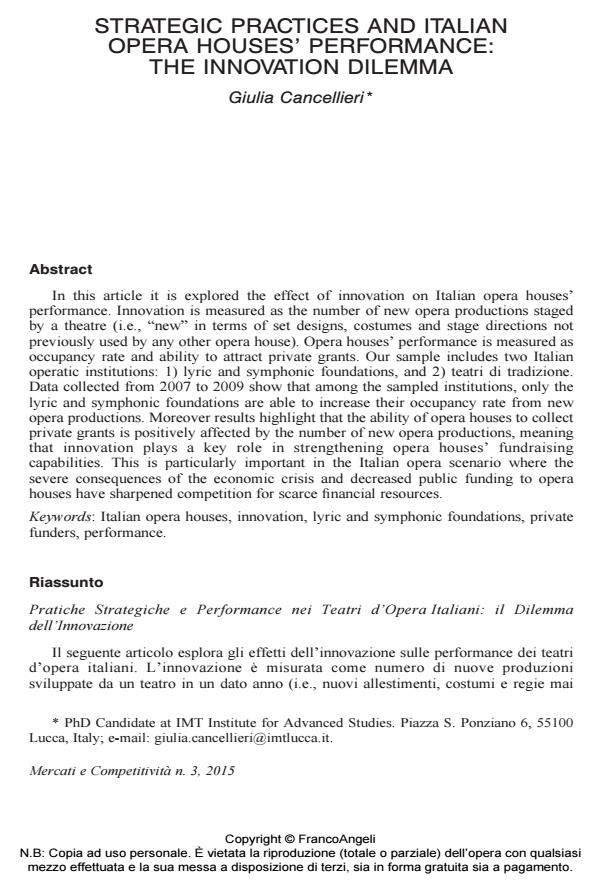Strategic practices and italian opera houses’ performance: the innovation dilemma
Journal title MERCATI E COMPETITIVITÀ
Author/s Giulia Cancellieri
Publishing Year 2015 Issue 2015/3
Language Italian Pages 21 P. 39-59 File size 548 KB
DOI 10.3280/MC2015-003003
DOI is like a bar code for intellectual property: to have more infomation
click here
Below, you can see the article first page
If you want to buy this article in PDF format, you can do it, following the instructions to buy download credits

FrancoAngeli is member of Publishers International Linking Association, Inc (PILA), a not-for-profit association which run the CrossRef service enabling links to and from online scholarly content.
In this article it is explored the effect of innovation on Italian opera houses’ performance. Innovation is measured as the number of new opera productions staged by a theatre (i.e., "new" in terms of set designs, costumes and stage directions not previously used by any other opera house). Opera houses’ performance is measured as occupancy rate and ability to attract private grants. Our sample includes two Italian operatic institutions: 1) lyric and symphonic foundations, and 2) teatri di tradizione. Data collected from 2007 to 2009 show that among the sampled institutions, only the lyric and symphonic foundations are able to increase their occupancy rate from new opera productions. Moreover results highlight that the ability of opera houses to collect private grants is positively affected by the number of new opera productions, meaning that innovation plays a key role in strengthening opera houses’ fundraising capabilities. This is particularly important in the Italian opera scenario where the severe consequences of the economic crisis and decreased public funding to opera houses have sharpened competition for scarce financial resources.
Le dimensioni di performance esplorate nel presente studio si focalizzano sul tasso di occupazione della sala e sulla capacità del teatro di reperire fondi da sostenitori privati. Il sample include due tipologie di istituzioni operistiche: le fondazioni lirico sinfoniche e i teatri di tradizione. I dati, raccolti dal 2007 al 2009, mostrano che soltanto le fondazioni lirico sinfoniche migliorano la loro occupancy portando in scena nuove produzioni. Inoltre, i risultati indicano che la capacità dei teatri d’opera di attrarre fondi privati è influenzata positivamente dallo sviluppo di nuove produzioni. Ciò evidenzia come l’innovazione operistica abbia un ruolo rilevante nel rafforzare le capacità di fundraising dei teatri. Il raggiungimento di tale obiettivo è particolarmente importante nello scenario italiano, dove le conseguenze della crisi e la riduzione dei finanziamenti pubblici hanno inasprito la competizione tra i teatri per l’attrazione di risorse sempre più scarse.
Keywords: Italian opera houses, innovation, lyric and symphonic foundations, private funders, performance.
Giulia Cancellieri, Strategic practices and italian opera houses’ performance: the innovation dilemma in "MERCATI E COMPETITIVITÀ" 3/2015, pp 39-59, DOI: 10.3280/MC2015-003003